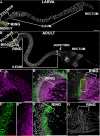The Drosophila hindgut lacks constitutively active adult stem cells but proliferates in response to tissue damage
- PMID: 19699165
- PMCID: PMC2772661
- DOI: 10.1016/j.stem.2009.06.003
The Drosophila hindgut lacks constitutively active adult stem cells but proliferates in response to tissue damage
Abstract
The adult Drosophila hindgut was recently reported to contain active, tissue-replenishing stem cells, like those of the midgut, but located within an anterior ring so as to comprise a single giant crypt. In contrast to this view, we observed no active stem cells and little cell turnover in adult hindgut tissue based on clonal marking and BrdU incorporation studies. Again contradicting the previous proposal, we showed that the adult hindgut is not generated by anterior stem cells during larval/pupal development. However, severe tissue damage within the hindgut elicits cell proliferation within a ring of putative quiescent stem cells at the anterior of the pylorus. Thus, the hindgut does not provide a model of tissue maintenance by constitutively active stem cells, but has great potential to illuminate mechanisms of stress-induced tissue repair.
Figures




Comment in
-
Stem cell in the adult Drosophila hindgut: just a sleeping beauty.Cell Stem Cell. 2009 Sep 4;5(3):227-8. doi: 10.1016/j.stem.2009.08.013. Cell Stem Cell. 2009. PMID: 19733527
References
-
- Buchon N, Broderick NA, Poidevin M, Pradervand S, Lemaitre B. Drosophila intestinal response to bacterial infection: activation of host defense and stem cell proliferation. Cell host & microbe. 2009;5:200–211. - PubMed
-
- Casali A, Batlle E. Intestinal Stem Cells in Mammals and Drosophila. Cell Stem Cell. 2009;4:124–127. - PubMed
-
- Dor Y, Brown J, Martinez OI, Melton DA. Adult pancreatic beta-cells are formed by self-duplication rather than stem-cell differentiation. Nature. 2004;429:41–46. - PubMed
Publication types
MeSH terms
Substances
Grants and funding
LinkOut - more resources
Full Text Sources
Other Literature Sources
Molecular Biology Databases

